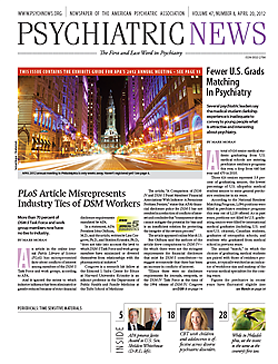The American Academy of Child and Adolescent Psychiatry (AACAP) has taken another step toward increased collaboration on children’s mental health issues by issuing a new guide to help community service systems better understand the role of psychotropic drugs in treating young people with psychiatric diagnoses.
“Medications are just one part of the treatment collaboration,” said Peter Metz, M.D., a clinical professor of psychiatry at the University of Massachusetts, speaking at an AACAP teleconference announcing a guide to medications for community-based agencies serving children.
“We want to convey to our partners that child and adolescent psychiatrists can do more than diagnose DSM-IV disorders and prescribe medications,” said Metz.
The guide is intended for professionals working in child welfare, education, juvenile justice, substance abuse, and developmental disabilities. It is the product of years of work by AACAP members, with partial funding provided by the federal Substance Abuse and Mental Health Services Administration.
The systems-of-care model, with its coordinated networks of supports for the child, underlies the document’s structure.
The guide emphasizes a “collaborative, team effort” in a biopsychosocial framework to treat emotional or behavioral problems in young people, said the authors.
“Medication facilitates being able to engage in the other parts of treatment,” stated Marcia Slattery, M.D., M.H.S., an associate professor of psychiatry, psychology, and pediatrics at the University of Wisconsin School of Medicine and Public Health, in an interview with Psychiatric News.
“As the document says, medication ‘removes physiologically based obstacles to change’ and allows the patient to engage more in other treatment modalities,” noted Slattery, who was not an author of the guide.
The 24-page guide explains that “the benefit from the medicine must be evaluated against the potential unwanted side effects” of drugs and that dosage levels can be “cautiously” decreased after a time to the lowest effective levels. The guide’s authors warn against any sudden discontinuation of psychotropic medications. They also emphasize the need to inform parents and children about the place of medications in the overall treatment plan.
“Most of the time, young people understand the value of medications in treating their illness,” said Slattery. “But when they do not agree at first, therapists can use other forms of treatment and later revisit the question of medications, if it is helpful.”
By working on the therapeutic alliance with the patient, a clinician can eventually reintegrate medications in the context of a broader treatment plan, she pointed out.
The guide also addresses key issues familiar to psychiatrists but perhaps less so to professionals in other fields— off-label medication use, FDA black-box warnings, insurance company preferred drug lists, polypharmacy, and the need for increased caution when considering medications for use with young children.
“The guide is not intended to supply clinical details of any specific psychotropic medication,” said Metz. “Rather, it outlines general principles and procedures with illustrative examples in a way that is succinct and approachable for our audience.”
“Child psychiatrists are trained to integrate all these pieces, but they have a long way to go to educate people that medications are a piece of the treatment and not the sole treatment,” said Slattery. “The document emphasizes that meds are one component of the treatment plans and that should be communicated to patients, parents, and agency professionals.”
None of the 15 members of the committee that drew up the guide receives funding from the pharmaceutical industry, so there was no conflict of interest that might have influenced the content of the medication information, said Metz.

AACAP’s “A Guide for Community Child Serving Agencies on Psychotropic Medications for Children and Adolescents” is posted here. 